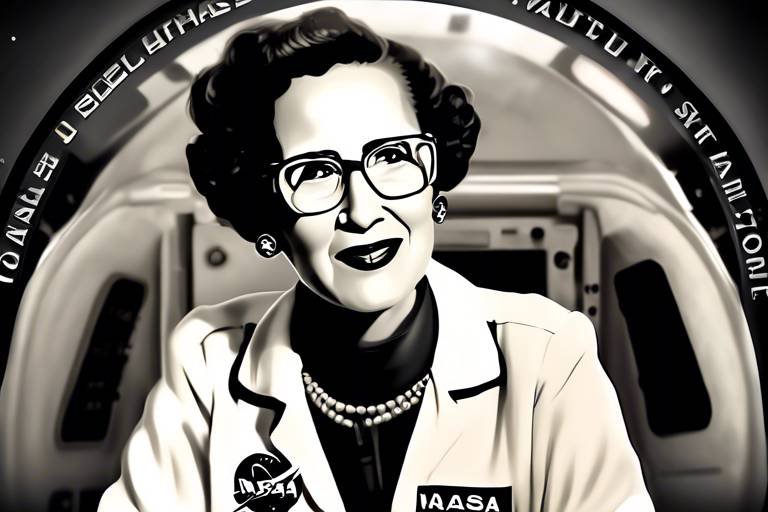The Pioneering Research of Richard N. Zare in Chemistry
Richard N. Zare is a name that resonates deeply within the scientific community, particularly in the realm of chemistry. His groundbreaking contributions have not only expanded our understanding of chemical processes but have also paved the way for innovative techniques that are now fundamental in research and industry. Imagine a world where scientists can observe chemical reactions in real-time, almost like watching a movie unfold. This is the reality that Zare has helped create through his pioneering research. His work exemplifies the intersection of creativity and science, showcasing how curiosity can lead to revolutionary discoveries that change the way we see the world.
From his early days as a curious student to becoming a leading figure in chemistry, Zare's journey is a testament to the power of passion and perseverance. His innovative spirit has led to advancements in laser techniques and chemical kinetics, which have transformed the landscape of chemical analysis. These contributions have not only enhanced our understanding of molecular dynamics but have also provided tools that other scientists can use to explore the intricate dance of atoms and molecules. The excitement and energy surrounding his work are palpable, as he continues to inspire a new generation of chemists eager to push the boundaries of what we know.
As we delve deeper into Zare's contributions, we uncover a rich tapestry of research that spans decades. His advancements in spectroscopy have opened new avenues for analyzing molecular structures, allowing us to peek into the very fabric of matter. Furthermore, his commitment to education and mentorship has fostered an environment where innovation thrives, ensuring that the legacy of his work will endure for generations to come. In a world that often feels disconnected, Zare's interdisciplinary collaborations remind us of the importance of unity in scientific exploration, demonstrating that the most profound discoveries often arise from diverse perspectives working together.
- What are Richard N. Zare's most notable contributions to chemistry?
Zare is known for his pioneering work in laser techniques, chemical kinetics, and advancements in spectroscopy, which have significantly impacted chemical analysis. - How has Zare influenced the field of education in chemistry?
He has mentored numerous students and researchers, fostering a new generation of chemists who continue to innovate in the field. - What is the significance of Zare's interdisciplinary collaborations?
These collaborations highlight the interconnectedness of scientific research and demonstrate how diverse fields can come together to solve complex problems. - What areas is Zare currently researching?
His current research focuses on nanotechnology and environmental chemistry, addressing contemporary challenges through innovative approaches.

Early Life and Education
Richard N. Zare was born on June 24, 1939, in the bustling city of New York, where the vibrant atmosphere of the 1940s and 50s would play a crucial role in shaping his inquisitive mind. Growing up in a family that valued education, Zare was encouraged to explore the world around him. From a young age, he exhibited a keen interest in science, often conducting small experiments using household items. It was this early exposure that ignited his passion for chemistry, leading him down a path of discovery and innovation.
His academic journey began at the University of California, Berkeley, where he pursued a Bachelor of Arts in Chemistry. The university was a hotbed of scientific advancement, and Zare was fortunate to study under some of the most brilliant minds in the field. The rigorous curriculum and collaborative environment fostered his analytical skills and deepened his understanding of chemical principles. It was during this time that he became fascinated with the potential of lasers, a technology that would later become a cornerstone of his research.
After completing his undergraduate degree, Zare continued his education at Columbia University, where he earned his Ph.D. in Chemistry in 1964. His doctoral research focused on the dynamics of chemical reactions, a topic that would lay the groundwork for many of his future contributions. Zare's time at Columbia was marked by intense study and groundbreaking discoveries, as he delved into the intricate world of molecular interactions. His mentors recognized his potential early on, often encouraging him to push the boundaries of conventional wisdom.
Throughout his educational journey, Zare was not just a passive learner; he actively engaged in research projects that often led to significant findings. For instance, during his time at Berkeley, he participated in a project that examined the behavior of molecules under varying conditions, which honed his skills in experimental design and data analysis. This hands-on experience was invaluable and would later inform his innovative approaches to chemical analysis.
In addition to his formal education, Zare's early life was enriched by various experiences that broadened his perspective. He often attended science fairs and public lectures, where he met other passionate scientists and engaged in discussions that fueled his curiosity. These interactions were instrumental in developing his critical thinking skills and his understanding of the scientific method.
In summary, Richard N. Zare's early life and education were characterized by a blend of curiosity, rigorous academic training, and influential mentorship. These elements combined to create a solid foundation for his future endeavors in chemistry, setting the stage for a career that would not only advance scientific knowledge but also inspire generations of chemists to come.

Innovative Laser Techniques
Richard N. Zare has truly carved a niche for himself in the world of chemistry through his . Imagine a world where scientists can observe molecular interactions with the same clarity as watching a live performance—this is the essence of Zare's contributions. His work has not only enhanced our understanding of chemical processes but has also paved the way for groundbreaking applications across various scientific fields.
At the heart of Zare's innovation is the use of lasers in chemical analysis. Traditional methods of studying chemical reactions often lacked the precision required to understand rapid molecular dynamics. However, Zare's pioneering use of laser-induced fluorescence has transformed this landscape. By utilizing lasers to excite molecules, he enabled researchers to detect and analyze the emitted light, providing critical insights into the behavior of molecules during reactions. This technique has significantly increased the resolution and sensitivity of chemical analysis, allowing scientists to observe reactions in real-time.
One of Zare's notable achievements is the development of time-resolved laser spectroscopy. This technique allows scientists to capture transient species that are often elusive and short-lived during chemical reactions. Think of it as having a high-speed camera for molecular interactions—Zare's work has made it possible to "freeze" moments in chemical processes that were previously unobservable. This capability has fundamentally changed how we study reaction mechanisms and has opened new avenues for research.
Furthermore, Zare's laser techniques have applications beyond pure chemistry. His methods are utilized in fields such as biochemistry, environmental science, and even materials science. For instance, in environmental chemistry, laser techniques can help in detecting pollutants at incredibly low concentrations, thereby aiding in the development of strategies to combat environmental challenges. The versatility of his innovations showcases the profound impact of laser technology on various scientific disciplines.
To illustrate the significance of Zare's laser techniques, consider the following table highlighting some of the key applications:
| Application | Description |
|---|---|
| Chemical Kinetics | Understanding reaction rates and mechanisms through real-time observation. |
| Environmental Monitoring | Detecting and analyzing pollutants in air and water with high sensitivity. |
| Biochemical Assays | Studying interactions between biomolecules, aiding drug discovery and development. |
| Material Characterization | Analyzing the properties of materials at the molecular level for better performance. |
In summary, Richard N. Zare's innovative laser techniques have not only revolutionized chemical analysis but have also laid the groundwork for interdisciplinary research. His ability to harness the power of lasers to explore the intricacies of molecular behavior has opened doors to new scientific possibilities. As we continue to unravel the mysteries of chemistry, Zare's contributions will undoubtedly remain at the forefront, inspiring future generations of scientists to push the boundaries of what we know.
- What are laser-induced fluorescence techniques?
Laser-induced fluorescence techniques involve using lasers to excite molecules, allowing scientists to detect the emitted light and gain insights into molecular behavior. - How has Zare's work impacted environmental science?
Zare's laser techniques enable the detection of pollutants at very low concentrations, aiding in environmental monitoring and protection efforts. - What is time-resolved laser spectroscopy?
Time-resolved laser spectroscopy is a method that allows scientists to capture short-lived molecular species during chemical reactions, providing valuable information about reaction mechanisms.

Contributions to Chemical Kinetics
Richard N. Zare has made significant contributions to the field of chemical kinetics, which is the study of the rates of chemical reactions and the factors that influence these rates. His innovative approaches have not only enhanced our understanding of reaction mechanisms but have also paved the way for practical applications in various industries. Imagine trying to bake a cake without knowing how long to leave it in the oven or at what temperature—it’s a recipe for disaster! Similarly, understanding the kinetics of chemical reactions is crucial for predicting outcomes in both laboratory and industrial settings.
One of Zare's key contributions involves the use of laser-induced fluorescence (LIF) techniques. By employing these techniques, Zare was able to observe and analyze the dynamics of chemical reactions in real-time. This method allows scientists to track the movement of molecules during a reaction, providing insights into how quickly they react and what intermediates may form along the way. Think of it as having a high-speed camera that captures every moment of a thrilling car race; you can see exactly how the cars maneuver through the track, which is similar to how Zare’s techniques allow us to visualize molecular interactions.
Moreover, Zare's research has focused on the temperature and pressure dependencies of various reactions. By systematically varying these conditions, he has helped elucidate the Arrhenius equation, which describes how reaction rates increase with temperature. This understanding is fundamental for chemists who need to optimize reaction conditions for everything from pharmaceuticals to energy production. For instance, consider a factory that produces a vital chemical; knowing the precise temperature at which the reaction occurs most efficiently can lead to significant cost savings and increased yields.
Additionally, Zare's work has also shed light on the concept of transition states—the fleeting configurations of atoms that occur during a reaction. By utilizing advanced spectroscopic techniques, he has contributed to our understanding of how these states influence the speed and outcome of reactions. This is akin to understanding the critical moment in a sports game where a player must make a split-second decision, which ultimately determines the game’s outcome. In chemistry, identifying these transition states allows scientists to manipulate reactions to favor the desired products.
In summary, Richard N. Zare's contributions to chemical kinetics have not only expanded our theoretical knowledge but have also provided practical tools for chemists to harness in their research and industrial applications. His pioneering work continues to inspire new generations of scientists to delve deeper into the intricacies of chemical reactions, enabling advancements that can lead to groundbreaking discoveries and innovations.
- What is chemical kinetics? Chemical kinetics is the study of the rates of chemical reactions and how different conditions affect these rates.
- How did Richard N. Zare contribute to chemical kinetics? Zare developed innovative techniques such as laser-induced fluorescence to study molecular dynamics and reaction mechanisms in real-time.
- Why are transition states important in chemical reactions? Transition states are crucial because they represent the highest energy point during a reaction, influencing the speed and direction of the reaction.
- What are some practical applications of Zare's research? His research aids in optimizing industrial chemical processes, improving pharmaceutical development, and enhancing energy production methods.

Impact on Spectroscopy
Richard N. Zare's contributions to the field of spectroscopy have been nothing short of revolutionary. By harnessing the power of laser technology, Zare has opened up new avenues for understanding molecular structures and behaviors. His innovative approaches have not only enhanced traditional spectroscopic techniques but have also introduced entirely new methods for analyzing chemical compounds. Imagine trying to solve a complex puzzle without all the pieces; that's what chemists faced before Zare's advancements. Now, with his techniques, they can see the full picture with remarkable clarity.
One of Zare's most notable contributions is the development of laser-induced fluorescence (LIF). This technique allows scientists to observe the fluorescence of molecules when they are excited by a laser light. The precision and sensitivity of LIF have made it a cornerstone in the study of chemical kinetics and molecular interactions. For instance, researchers can now monitor the behavior of molecules in real-time, providing insights that were previously unattainable. This capability is akin to having a high-definition camera capturing the intricate dance of molecules as they react with one another.
Furthermore, Zare's work has significantly impacted various applications across multiple fields. From environmental science to pharmaceuticals, the ability to analyze molecular structures with such precision has led to groundbreaking discoveries. For example, in environmental chemistry, Zare's techniques are used to detect pollutants at incredibly low concentrations, making it possible to address issues like air and water quality more effectively.
To illustrate the breadth of Zare's impact on spectroscopy, consider the following table, which highlights key techniques and their applications:
| Technique | Application |
|---|---|
| Laser-Induced Fluorescence (LIF) | Real-time monitoring of chemical reactions |
| Raman Spectroscopy | Identifying molecular compositions |
| Time-Resolved Spectroscopy | Studying fast chemical reactions |
| Mass Spectrometry Coupled with Laser Techniques | Analyzing complex mixtures |
In addition to these techniques, Zare has championed the importance of interdisciplinary collaboration in spectroscopy. His partnerships with physicists and engineers have led to the creation of advanced instruments that push the boundaries of what is possible in molecular analysis. This collaborative spirit is essential, as it brings together diverse expertise to tackle complex scientific questions. Just as a symphony requires different instruments to create a harmonious sound, so too does modern science thrive on collaboration.
As we look to the future, the impact of Zare's work on spectroscopy will undoubtedly continue to resonate. His innovations have laid the groundwork for future discoveries, inspiring a new generation of scientists to explore the molecular world with the same passion and curiosity that he embodies. In a field that constantly evolves, Zare's legacy serves as a beacon, guiding researchers toward new frontiers and encouraging them to ask the questions that lead to groundbreaking discoveries.
- What is laser-induced fluorescence (LIF)? LIF is a technique that uses laser light to excite molecules, causing them to emit fluorescence, which can be measured to gain insights into molecular behavior.
- How has Richard N. Zare influenced modern spectroscopy? Zare's innovative techniques, particularly in laser spectroscopy, have revolutionized the way scientists analyze molecular structures and chemical reactions.
- What are some applications of Zare's spectroscopic techniques? His techniques are widely used in environmental science, pharmaceuticals, and materials science, among other fields.

Role in Education and Mentorship
Richard N. Zare has not only made remarkable strides in the field of chemistry through his innovative research but has also played a pivotal role in shaping the future of the discipline by dedicating himself to education and mentorship. His influence extends far beyond the laboratory; it reaches into classrooms and research facilities where he has inspired countless students. Zare's approach to teaching is characterized by a deep commitment to fostering curiosity and critical thinking among his students. He believes that education is not merely about transferring knowledge, but about igniting a passion for discovery that can last a lifetime.
Throughout his career, Zare has mentored a diverse group of students, many of whom have gone on to make significant contributions to science and technology. He often emphasizes the importance of hands-on experience in the learning process, encouraging students to engage directly with research. By providing opportunities for undergraduate and graduate students to participate in cutting-edge projects, Zare has created an environment where students can learn the intricacies of scientific inquiry while developing their own unique ideas and approaches.
Moreover, Zare’s mentorship extends beyond the confines of traditional education. He has been known to cultivate a collaborative atmosphere, where students feel comfortable sharing their thoughts and questions. This nurturing environment is crucial in developing the next generation of chemists who are not only knowledgeable but also innovative thinkers. His students often describe him as a mentor who is approachable and genuinely interested in their personal and professional growth.
One of the standout features of Zare's mentorship style is his ability to connect interdisciplinary concepts. He encourages students to explore the intersections of chemistry with other fields, such as physics and biology. This holistic perspective not only broadens their understanding but also prepares them to tackle complex scientific challenges in a collaborative manner. As a result, many of Zare's mentees have pursued careers that bridge multiple disciplines, emphasizing the interconnectedness of scientific research.
In recognition of his contributions to education, Zare has received several awards, reflecting his dedication to teaching and mentorship. These accolades serve as a testament to the profound impact he has had on his students and the broader scientific community. Zare's legacy in education is not just about the knowledge he imparts, but also about the inspiration he provides to his students, encouraging them to push boundaries and explore new frontiers in science.
As we look to the future, Zare's role as an educator and mentor will undoubtedly continue to influence aspiring chemists. His commitment to fostering a culture of innovation and inquiry will inspire generations to come, ensuring that the field of chemistry remains vibrant and dynamic. Richard N. Zare exemplifies what it means to be a true educator—one who not only teaches but also inspires.
- What is Richard N. Zare known for?
Zare is renowned for his groundbreaking research in chemistry, particularly in the areas of laser techniques and chemical kinetics. - How has Zare influenced education in chemistry?
Through his mentorship, Zare has inspired countless students to pursue careers in science, fostering a culture of inquiry and innovation. - What awards has Richard N. Zare received?
He has received numerous accolades for his contributions to chemistry and education, reflecting his impact on both academia and industry.

Recognition and Awards
Throughout his remarkable career, Richard N. Zare has been the recipient of numerous prestigious awards and recognitions that underscore his profound impact on the field of chemistry. These accolades not only celebrate his innovative research but also highlight his role as a mentor and educator in the scientific community. From early on, Zare's contributions were acknowledged by various institutions, paving the way for a legacy that inspires future generations of chemists.
One of the most notable recognitions Zare received is the National Medal of Science, awarded by the President of the United States. This honor is bestowed upon individuals who have made outstanding contributions to science and technology. Zare's receipt of this medal is a testament to his groundbreaking work, particularly in the realms of laser chemistry and spectroscopy. His research has not only advanced scientific understanding but has also led to practical applications in various industries.
In addition to the National Medal of Science, Zare has garnered multiple awards from esteemed organizations such as the American Chemical Society (ACS) and the Royal Society of Chemistry (RSC). These awards often recognize his pioneering techniques and methodologies that have revolutionized chemical analysis. For instance, the Priestley Medal, awarded by the ACS, is one of the highest honors in the field, celebrating his extraordinary contributions to chemistry.
| Award | Year | Organization |
|---|---|---|
| National Medal of Science | 2000 | U.S. Government |
| Priestley Medal | 2011 | American Chemical Society |
| Robert A. Welch Award in Chemistry | 2013 | Welch Foundation |
| Wolf Prize in Chemistry | 2014 | Wolf Foundation |
Zare's influence extends beyond just his research. He has been actively involved in various professional societies and has served on numerous advisory boards, contributing to the advancement of chemistry as a whole. His commitment to education is evident in the many students he has mentored, many of whom have gone on to make their own significant contributions to the field.
In summary, the accolades and awards that Richard N. Zare has received throughout his career serve as a reflection of his dedication, innovation, and lasting impact on chemistry. As he continues to explore new scientific frontiers, his legacy will undoubtedly inspire future chemists to push the boundaries of knowledge and discovery.
- What is Richard N. Zare known for?
Zare is renowned for his pioneering work in laser chemistry and spectroscopy, significantly advancing the field of chemical analysis. - What major awards has Zare received?
He has received several prestigious awards, including the National Medal of Science and the Priestley Medal from the American Chemical Society. - How has Zare contributed to education?
Zare has mentored numerous students and has played a vital role in fostering the next generation of chemists.

Interdisciplinary Collaborations
Richard N. Zare's work is a shining example of how can lead to groundbreaking advancements in science. By bridging the gap between different fields, Zare has demonstrated that chemistry does not exist in isolation; rather, it is deeply intertwined with physics, biology, and engineering. This interconnectedness is crucial, especially in today's complex scientific landscape where problems often require multifaceted solutions.
One of the remarkable aspects of Zare's collaborative efforts is his ability to bring together experts from various disciplines to tackle pressing issues. For instance, his partnerships with physicists have led to advancements in laser technology that are not only revolutionary for chemical analysis but have also found applications in fields like medicine and environmental science. Imagine the precision of a laser being utilized to detect pollutants in our water supply—this is just one example of how Zare's interdisciplinary approach has real-world implications.
Moreover, Zare's collaborations with biologists have opened new avenues in understanding biochemical processes at a molecular level. By applying his innovative laser techniques, researchers can now observe the dynamics of biological reactions in real-time, leading to discoveries that could potentially revolutionize drug development and disease treatment. This is akin to having a microscope that not only shows you the structure of a cell but also allows you to watch the cell's processes as they happen, providing invaluable insights.
In addition to his work with physicists and biologists, Zare has also partnered with engineers to develop new instruments and methodologies that enhance the capabilities of chemical analysis. For example, the development of sophisticated spectroscopic tools has been a direct result of these collaborations. These instruments enable scientists to analyze complex mixtures and identify compounds with a level of precision that was previously unattainable.
The essence of Zare's interdisciplinary collaborations can be summarized as follows:
| Discipline | Collaborative Focus | Impact |
|---|---|---|
| Chemistry | Laser Techniques | Enhanced precision in chemical analysis |
| Physics | Instrumentation Development | New methodologies for studying molecular dynamics |
| Biology | Biochemical Processes | Real-time observation of reactions |
| Engineering | Instrument Design | Advanced tools for chemical analysis |
Through these collaborations, Zare not only contributes to his own field but also enriches the scientific community as a whole. His ability to foster partnerships across disciplines encourages a culture of innovation and creativity, proving that when experts from different backgrounds come together, they can achieve far more than they could alone. This holistic approach not only addresses immediate scientific challenges but also inspires future generations of scientists to think beyond traditional boundaries.
Ultimately, Zare's interdisciplinary collaborations serve as a reminder that the future of science lies in our ability to work together. As we face increasingly complex global challenges, the need for collaborative efforts across various scientific domains has never been more critical. Richard N. Zare’s legacy in this regard will undoubtedly inspire future researchers to embrace the power of collaboration in their quest for knowledge and discovery.
- What is Richard N. Zare known for?
Zare is renowned for his pioneering work in laser techniques and chemical kinetics, which have significantly advanced the field of chemistry. - How has Zare contributed to interdisciplinary research?
He has collaborated with experts in physics, biology, and engineering to develop new methods and technologies that enhance our understanding of chemical processes. - What impact have his collaborations had on real-world applications?
Zare's work has led to advancements in areas such as environmental monitoring, drug development, and analytical chemistry. - Why is interdisciplinary collaboration important in science?
It allows for a more comprehensive approach to solving complex problems, leveraging diverse expertise to foster innovation and discovery.

Current Research Focus
Today, Richard N. Zare is at the forefront of several cutting-edge research areas that are not only fascinating but also crucial in addressing some of the most pressing challenges of our time. One of his primary focuses is on nanotechnology, a field that has the potential to revolutionize industries ranging from medicine to electronics. Zare is particularly interested in how nanoscale materials can be utilized to create more efficient chemical reactions and improve the delivery of drugs within the body. Imagine tiny robots performing surgery or targeted therapies that can zero in on cancer cells without harming surrounding tissues—this is the promise of nanotechnology, and Zare's work is helping to make it a reality.
In addition to nanotechnology, Zare is also deeply engaged in environmental chemistry. As the world grapples with climate change and pollution, his research aims to develop innovative solutions to mitigate these issues. For instance, he is exploring ways to enhance the efficiency of catalysts that can break down harmful pollutants in the atmosphere and water bodies. This research is not just academic; it has real-world implications for improving air quality and protecting our ecosystems. By harnessing advanced chemical techniques, Zare is paving the way for cleaner, more sustainable practices.
Another exciting area of Zare's current research involves the study of molecular interactions at unprecedented levels of detail. Using his innovative laser techniques, he is able to observe and manipulate chemical reactions in real time, providing insights that were previously unattainable. This work not only deepens our understanding of fundamental chemistry but also has practical applications in developing new materials and improving industrial processes. The ability to visualize molecular dynamics opens up a world of possibilities, much like watching a slow-motion replay of a sports game to see every intricate move unfold.
To summarize, Richard N. Zare's current research focuses on:
- Nanotechnology: Developing nanoscale materials for improved chemical reactions and drug delivery.
- Environmental Chemistry: Creating efficient catalysts to reduce pollution and enhance sustainability.
- Molecular Interactions: Observing chemical reactions in real-time to gain deeper insights into molecular dynamics.
These areas of research not only highlight Zare's commitment to advancing scientific knowledge but also his dedication to applying this knowledge to solve real-world problems. As he continues to push the boundaries of what is possible in chemistry, his work serves as an inspiration to both current and future generations of scientists.
Q1: What is Richard N. Zare known for?
A1: Richard N. Zare is renowned for his pioneering contributions to the field of chemistry, particularly in laser techniques, chemical kinetics, and spectroscopy.
Q2: How has Zare impacted education?
A2: Zare has mentored numerous students and young researchers, significantly influencing the next generation of chemists and fostering innovation in the field.
Q3: What are the implications of Zare's research in nanotechnology?
A3: His research in nanotechnology has the potential to revolutionize drug delivery systems and improve various industrial processes, leading to more efficient and targeted therapies.
Q4: How does Zare's work address environmental challenges?
A4: Zare's research in environmental chemistry focuses on developing catalysts that can break down pollutants, contributing to cleaner air and water.
Q5: What is the significance of studying molecular interactions?
A5: Understanding molecular interactions allows scientists to predict and manipulate chemical reactions, leading to advancements in material science and industrial applications.

Legacy and Future Directions
Richard N. Zare's legacy in the field of chemistry is nothing short of remarkable. His groundbreaking research has not only advanced our understanding of chemical processes but has also paved the way for future innovations in various scientific disciplines. Zare's work exemplifies the essence of curiosity-driven research, where the quest for knowledge leads to unexpected discoveries that can transform entire fields. As we look to the future, his influence continues to inspire new generations of scientists who are eager to explore the unknown.
One of the most significant aspects of Zare's legacy is his commitment to interdisciplinary collaboration. He has shown that the boundaries between scientific fields are often blurred, and many of the most exciting developments arise from the convergence of different disciplines. For instance, his collaborations with physicists and biologists have opened new avenues in chemical research, leading to innovative solutions for complex problems. This approach not only enriches the scientific community but also fosters a culture of shared knowledge and creativity.
Looking ahead, the future directions of Zare's research are particularly exciting. His current focus on nanotechnology and environmental chemistry positions him at the forefront of addressing some of the most pressing challenges of our time. As the world grapples with issues such as climate change and pollution, Zare's innovative techniques and insights are crucial for developing sustainable solutions. By harnessing the power of nanotechnology, he aims to create materials and processes that minimize environmental impact while enhancing efficiency.
Moreover, Zare's emphasis on education and mentorship ensures that his legacy will endure for years to come. By nurturing the next generation of chemists, he is not only passing on knowledge but also instilling a passion for discovery and innovation. His former students, many of whom have gone on to make significant contributions to science, serve as a testament to his impact as an educator. As they carry forward his teachings and values, the spirit of exploration and inquiry that Zare embodies will continue to thrive.
In conclusion, Richard N. Zare's legacy is a blend of groundbreaking research, interdisciplinary collaboration, and a profound commitment to education. As we stand on the brink of new scientific horizons, his work serves as a guiding light, encouraging us to embrace curiosity and innovation. The future of chemistry is bright, and with leaders like Zare at the helm, we can expect to see remarkable advancements that will shape our understanding of the world for generations to come.
- What are Richard N. Zare's most notable contributions to chemistry?
Zare is known for his pioneering laser techniques, advancements in spectroscopy, and significant research in chemical kinetics. - How has Zare influenced the field of education in chemistry?
He has mentored countless students, fostering a new generation of chemists who continue to innovate and explore in the field. - What current research areas is Zare focusing on?
His current research includes nanotechnology and environmental chemistry, addressing contemporary challenges through innovative approaches. - Why is interdisciplinary collaboration important in Zare's work?
Collaborations across disciplines lead to innovative solutions and a deeper understanding of complex scientific problems.
Frequently Asked Questions
- What are Richard N. Zare's most significant contributions to chemistry?
Richard N. Zare has made groundbreaking contributions in various areas, notably through his innovative laser techniques that revolutionized chemical analysis. His work in chemical kinetics has deepened our understanding of reaction mechanisms, while his advancements in spectroscopy have provided new methods for analyzing molecular structures. These contributions have significantly shaped modern chemistry.
- How did Zare's early life influence his career in chemistry?
Richard N. Zare's early life and education played a crucial role in shaping his scientific curiosity. Growing up in an environment that encouraged inquiry and exploration laid the groundwork for his passion for research. His academic experiences fostered a deep understanding of chemistry, which he later applied to his pioneering work.
- What impact has Zare had on education and mentorship in chemistry?
Zare has had a profound impact on education, mentoring numerous students throughout his career. His dedication to teaching and guiding the next generation of chemists has fostered an environment of innovation and exploration in the field. Many of his mentees have gone on to make their own significant contributions to science.
- What interdisciplinary collaborations has Zare been involved in?
Richard N. Zare's research often transcends traditional boundaries, involving collaborations with physicists, biologists, and engineers. These interdisciplinary efforts highlight the interconnectedness of scientific research, allowing for a more comprehensive approach to solving complex problems in various fields.
- What are Zare's current research focuses?
Currently, Richard N. Zare is exploring new frontiers in chemistry, particularly in areas like nanotechnology and environmental chemistry. His research aims to address contemporary challenges, utilizing innovative techniques to advance our understanding and application of chemical principles.
- How has Zare's work influenced the field of spectroscopy?
Zare's advancements in spectroscopy have transformed the field by introducing new methods for analyzing molecular structures and behaviors. His work has paved the way for critical applications in various areas of chemistry, enhancing our ability to study and understand complex chemical systems.
- What legacy has Richard N. Zare left in the field of chemistry?
Richard N. Zare's legacy is profound, inspiring future generations of chemists to explore and innovate. His contributions have not only advanced scientific knowledge but have also encouraged an ongoing commitment to research and education in the ever-evolving landscape of chemistry.



















